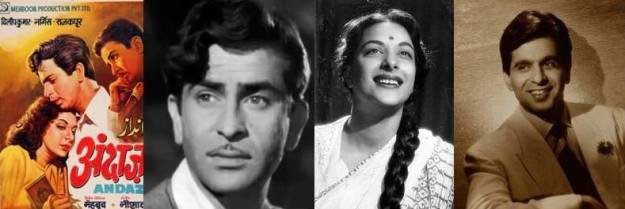
When I was a child, I used to hate art movies. I always wondered how could anyone like such boring movies, which had no story, no dance or songs, no action scenes. And strangely, such movies got National awards! I always doubted some sort of foul play behind the jury decision. Of course, my favourite movies and artists did get the Filmfare awards, but then why not National awards? I always blamed it on cheating, which was my word for corruption. When I got older, I obtained the wisdom that boring movies get National awards whereas exciting (and hence good) movies get Filmfare awards! When I was in my late 20s, somehow I decided to take another look at some of these boring stuff of Indian cinema. I started with Paar, then Trikaal, Chakra and so on. And hell, I was so annoyed at myself! How could I have not liked such movies earlier! These movies and the various artists therein are real gems. How have I missed them all these years! And then there was no looking back. I explored further and tried to watch as many Indian art movies as I could find. Though I did like the narrative and the way it unfolded, and the skills of the people involved in making such artwork, somehow I always had a feeling that I was missing something more subtle. What is the grammar of art — as one of my seniors once asked me — the basic set of rules which makes any creative work a piece of art? I did not have an answer then, and even today I am exploring the answer to that question.
Making movies is a creative work and demands both talent as well as training. Watching movies, like art appreciation, is also a skill. However, it is not difficult and if you consider some basic rules, I can assure you, your experience would increase manifold. And in the process you may also understand why a particular movie won the National award.
Art appreciation is a wide field and there are several aspects to it. Of course, in one single short post, I cannot handle all the issues involved. My approach, as in all other articles, is to give you a subtle hint, indicate certain well-defined patterns, and arouse your curiosity. Then I leave you to explore the field further on your own. No, it is not difficult, and definitely not boring. This is the approach followed by science teachers, and I had applied it in my earlier posts e.g, ‘Who broke Kanishka’s head?’, ‘A small word leads to a long history‘ and ‘Do surnames carry signatures of migration?‘
OK. Enough of introduction. Let us get to the business. In order to illustrate the various aspects of film-appreciation, I would continue to choose the theme Clash of Legends, which presents to us the best of Indian cinema. As I mentioned in the previous post, clash of legends is all about harmony and balance. I had also briefly discussed how to look at the different styles and approaches of the actors participating in the scene.
In this post, I would tell you about geometry, perspective and view angle. In other words, we would see how the basic rules of photography are also applied in creating movie scenes. Remember that just as photography had taken over hand-made portraits, in the same way movies had taken over theatre. However, theatre continues to exist as an art form. On the other hand, movies have evolved from being just an electronic adaptation of theatre to become an art form as well as a source of entertainment. At the same time, there are several features in movies which are not possible to appreciate in theatre and vice versa. Further, movies borrow several features from still photography. Note that filming movie scenes is very difficult than taking a still photograph because the subjects are in motion. Hence, it becomes enormously difficult to follow the basic rules of photography while filming a movie scene.
I suggest that you go through the rules of photography given in this article. Each rule has a scientific basis behind it, though you need not worry about it at this moment. If you are impatient, you may look at it later in your free time, and continue reading the present post. I will choose one movie scene and explain the various aspects as go along.
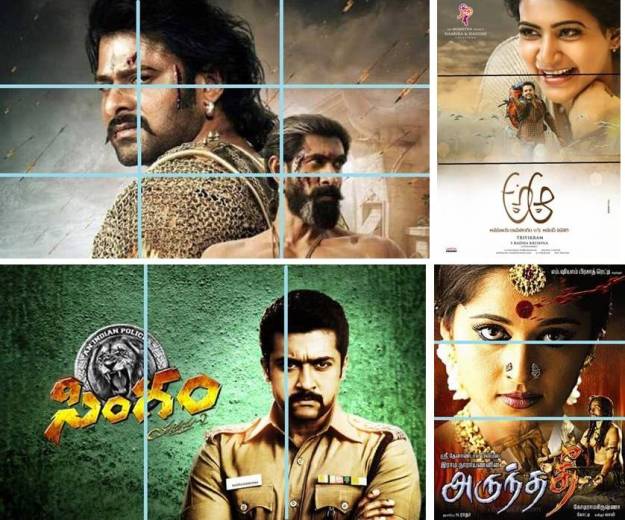
Subjects to be highlighted are positioned on the 1/3 lines. This holds true even when there is only one subject. Movie posters regularly highlight Samantha’s smile and Anushka’s eyes.
For the purpose of this article, I would make special mention of two rules. The most common rule of photography is the so called one-third rule whereby the total image area is divided into three equal vertical and horizontal segments (leading to 9 equal grid boxes). Any shot is arranged in such a way that the most important feature or subject falls on one of these lines, which I call as 1/3 line. Its scientific basis can be found in psychology and brain research, though we need not go into that detail here. This captures and holds the viewer’s attention on the two subjects. Note that it is not necessary that two subjects be present in the shot; the rule would still hold even if there is only one subject in the shot. Secondly, it is not necessary that the subject lies on vertical lines; horizontal lines could also be used for similar effect. Thus, while taking a fashion photograph, the upper 1/3 horizontal line could be made to pass through the model’s eyes and the lower 1/3 line through her lips.
The second rule is to look for leading lines which could be any line or linear structure which leads the viewer into and through the photograph. The leading line could be a staircase, a railing, a road, trees, lamp posts, or simply the horizon. The role of leading lines is similar to that of a guide in tourist places and museums. When you visit such places, there is so much to be seen that you feel overwhelmed. You may try to start at one end and explore everything that the place has to offer. However, without any prior knowledge, you would be losing a lot of time without learning anything worthwhile. In such cases, guides come to your aid. They help you and ‘guide’ you through the museum, showing everything in the order in which they are supposed to be seen. In the same way, leading lines guide your eyesight towards the most important portion of a photograph, where the drama is taking place.
The scene that I have chosen for discussion in this article is from classic Hindi movie Andaz (1949) with Raj Kapoor, Nargis and Dilip Kumar. First watch the scene in full, then we will discuss the various shots one by one, and finally you can watch the full scene all over again. If the video does not play, click on the “Watch on YouTube” link given therein.
This is a very nice scene in the sense that it is self-sufficient. One need not know the full story of the movie up to this moment, which had led to this particular scene. Just by following the various dialogues one can easily form a fairly accurate idea of what had been going on and what is going on. So I leave it on you, dear reader, to make the sense out of these dialogues, and restrict myself to discussion of this scene.
If you play the above video again, you would notice that both the rules that I described above have been religiously followed in nearly every shot. For example, in the photo below, Raj Kapoor and Nargis are positioned in such a way that the two 1/3 lines pass through them. In the next photo, the staircase is serving as the leading line.

In almost every shot of the scene, the 1/3 rule has been followed.
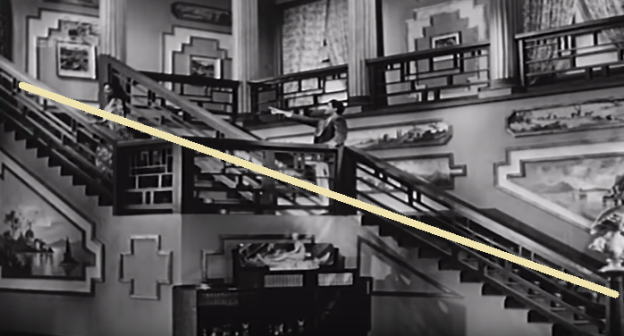
Stairs serve the purpose of leading lines here.
OK fine. Let us begin our analysis of this scene. As Nargis calls out, Raj Kapoor who had been climbing up the stairs, turns and asks, “Me?” This must have been frustrating to Nargis as there was no one else around! He climbs down with a feigned smile and with a casual tone and formal words asks,”Yes, Please!” At this instant, Nagis is standing on the 1/3 line whereas Raj Kapoor occupies the middle portion of the screen. This is not important since it is now Nargis’ turn to speak so she has to occupy the prominent position. However, it is important to notice the body languages of the actors — Nargis is still climbing up the stairs, and her head is facing upwards, as if pleading, praying. On the other hand, Raj Kapoor is looking down on her from a higher position, authoritatively.
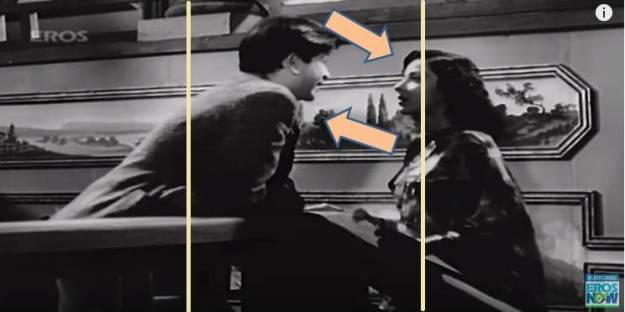
Raj Kapoor looks down on Nargis from a higher position.
The despondent look in Nargis’ eyes, sadness in her voice, and every expression of her face is screaming depression. She uses metaphor of the rose to ask whether Raj Kapoor has indeed lost interest in her. Raj Kapoor doesn’t have much to offer in reply; he smells and ignores the metaphor — though fully understanding it — and bypasses the question. He throws the rose away, or rather just firmly and rudely tells once and for all that he would not answer this question. That rose is caught by Dilip Kumar who has just entered the bungalow.
Both of them look at Dilip Kumar, Nargis immediately turns to Raj Kapoor — Oh my! This was an absolutely wrong time for him to have entered the scene. Nothing could be worse than this. Raj Kapoor’s smile and raised right eyebrow ridicule her — “Hello. Here comes your hero!” Nargis gets the message and decides not to continue with the argument — at least not in front of Dilip Kumar. She leaves, climbing up the stairs, with Raj Kapoor calling her to ask about a party they are supposed to attend in the evening. Here you can notice the absolutely brilliant use of the diagonal line from top left to bottom right of the screen. He announces that he won’t be able to attend it, and asks her to go with Dilip Kumar.
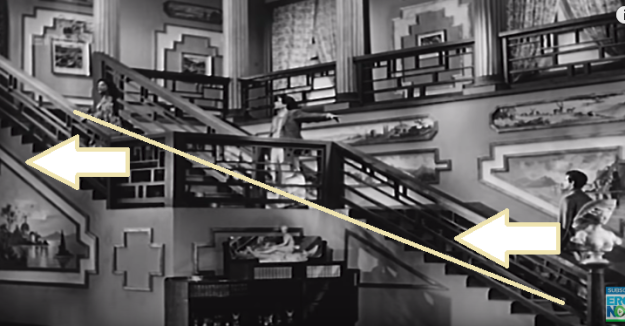
Dilip Kumar is entering as Nargis is leaving the scene. Note the use of leading lines.
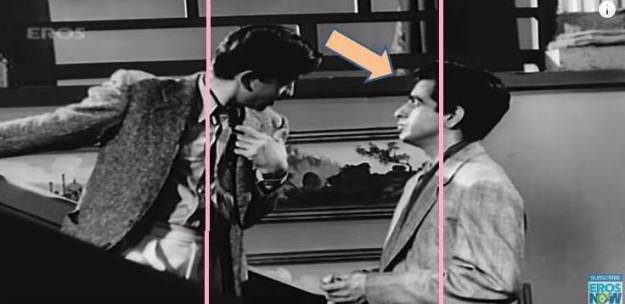
Raj Kapoor continues to occupy the dominating position, looking down at Dilip Kumar. Both actors stand on 1/3 lines.
Both of them are standing on the diagonal line. Dilip Kumar down, looking up, in a defensive position whereas Raj Kapoor is already on the podium, looking down and enjoying every bit of his position. His attitude is still quite frivolous and he successfully conveys the expression — “Look man, I know everything, but I give a damn nothing to it”. Dilip Kumar calls out and climbs up to him. “I want to say something to you”. “To me?” (Again!) The position is maintained, with Raj Kapoor still in commanding position and Dilip Kumar defensive, pleading. It is important to note that at this instant both the actors are standing on their corresponding 1/3 lines. It is simply because the whole scene depends on the harmony between the two actors.

Raj Kapoor looks out of the screen to indicate his unwillingness to have any discussion, whereas Dilip Kumar still looks into the screen space thus insisting on a conversation.
With a giggle, Raj Kapoor comes down. “Please go on!”. But then swiftly walks towards the right, facing right on the right edge of the screen, thus turning his back on Dilip Kumar. All this drama is meant to convey his reluctance or rather refusal to discuss anything. He would rather “walk out of the screen” and the discussion. He just holds the railing to remain in the scene. Dilip Kumar, meekly turns, and follows Raj Kapoor’s movement. The two have swapped their positions, but still occupying the 1/3 lines.

Raj Kapoor turns back and faces Dilip Kumar. The former’s body language at this particular instant is aggressive, authoritative and dominating. “Out with it!”
Dilip Kumar is silent, not knowing what to say, leading to a moment of silence. Raj Kapoor understands it, shows his magnanimity, but not unconditionally, and with a smile turns back, facing him. Now he is standing at the right edge, facing left. “What are you thinking?” His whole body language at this particular instant is very aggressive, authoritative and dominating. “Out with it!” Dilip Kumar walks up to him, looking straight into his eyes, without a single blink, signalling an upcoming confrontation. He walks and comes uncomfortably close to Raj Kapoor. Next shot.
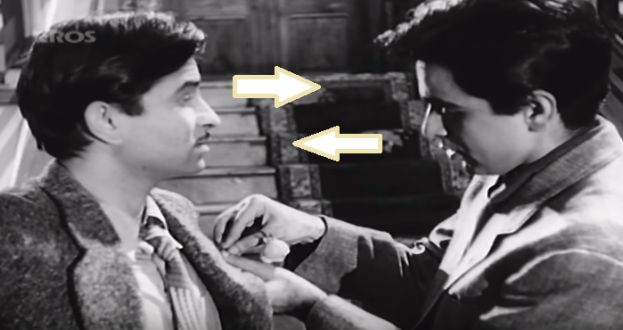
Dilip Kumar walks and comes uncomfortably close to Raj Kapoor. For the first and only time both face each other at the same level.
The two have swapped places, though occupying the 1/3 lines again, Raj Kapoor facing right while standing on the left, and Dilip Kumar facing left on the right side. Don’t worry if Raj Kapoor seems to be looking slightly upwards towards Dilip Kumar, the latter is of course a few centimeters taller. Dilip Kumar pins the rose into Raj Kapoor’s coat, a very unwelcome gesture, very intrusive and aggressive to the extreme. On top of that, he does it with a sweet and beautiful smile, with the sole purpose of showing the futility of Raj Kapoor’s caprices. “This flower looks good only on you.” Raj Kapoor takes it out, pins it back on Dilip Kumar, telling quite formally, “You are being formal Sir! This flower looks better on you.” No Sir, no takers for your favours! Dilip Kumar immediately takes it out and tells directly and philosophically, continuing with the metaphor that Nargis had used, “This is all your illusion, Sir.”
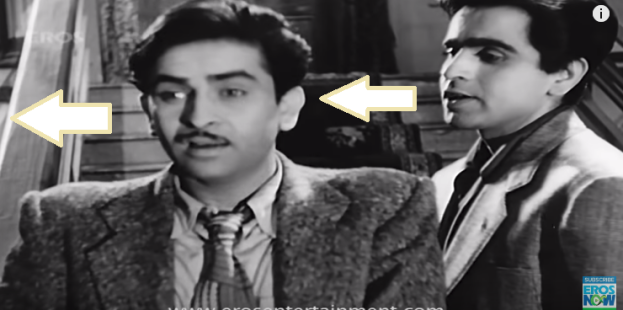
Raj Kapoor continues to look out of the screen showing his reluctance to any conversation.
Raj Kapoor snorts in mockery, turns round, and faces left while still standing on the left edge. No, he does not want to talk about it any further. “I am going away tonight. But before leaving, I wanted to resolve this misunderstanding that a priest having once offered a flower to deity, never offers it to anyone else.” Raj Kapoor is now annoyed to the extreme, his patience runs out, but he is already standing on the left edge. There is railing and absolutely no space for him to walk out of screen and the discussion; he is thus cornered. Feeling suffocated, he shouts and runs out of the scene — “Stop all this! All this talking means nothing”. Yes, he runs away, climbs up the stairs, stops only when he is once again at a higher position than Dilip Kumar, thus re-occupying his dominating position. To add extra weight to his position and to hammer the fact that he is the sole authority here, he throws the flower at Dilip Kumar — “And those priests don’t even exist anymore”.

Highly annoyed, Raj Kapoor runs away from the spot, and stops only when he has regained his dominating position.
There are several remarkable shots in the scene, which are too subtle to be described in words, but very well perceived by visual senses. Harmony is maintained throughout the scene by the lead players. Raj Kapoor’s character is in a dominant position, presumably he is wronged and thus, the ball is in his court. It is he who would decide whether to let go with the affair — forgive and forget — or to keep it. No negotiations possible. Dilip Kumar is every bit a gentleman, who in spite of being insulted, and being shown that he is not welcome, continues his efforts to resolve the conflict and misunderstanding. He earnestly wants peace and friendship in the various relationships and wants everyone to be happy. His body language throughout the scene is very restrained, calm and quiet. It is not feigned; it is real, genuine and compassionate. We all have met such people in our lives, who value friendships, and take relationships very seriously. In spite of various conflicts, they refuse to break the bond, instead make every effort to keep the bond intact and strong. In the process, they endure a lot and suffer many insults and injuries. They might be disturbed to the core, their hearts crying, but on the surface they remain calm and do not reveal their inner agitation to other people. It takes two to fight. If one person remains quiet, who the other one would fight with? That is the first mantra of conflict resolution, and the stronger person takes the initiative.
Raj Kapoor’s body language is very casual and carefree, with occasional spells of laughter, giggles and smiles, most of which are fake and feigned. He knows all — at least he thinks that he knows all. It could be his illusion or misunderstanding, but he does not think so. To him, he has been wronged, cheated, let down. He is offended, deeply offended, and is angry, very very angry. He fights and struggles really hard to keep calm and maintain his mental balance, something which he is finding immensely difficult to accomplish. So he invokes humour and cheerfulness to hide his agitation. Throughout the scene he maintains this attitude, except in the last shot. He is seen restless in every frame, not confronting anyone, always trying to walk out of the discussion, which is anyhow useless because he has already made up his mind. No negotiations possible. Sorry, discussions closed.
These are the various details of the scene which I could notice. If there is any other detail which I have missed, please do point it out. I would be happy to know your perspective.
To have a look at other articles in the Clash Of The Legends series, click here.
Photo source: Bahubali poster: Uttaranchal Today, Singam poster: hotstar, A Aa poster: Idlebrain, Arundhati poster: Pinterest, Andaz poster: Wikipedia, Raj Kapoor: Wikipedia, Nargis: Wikipedia, Dilip Kumar: Quora, Andaz movie stills: YouTube. All photos used for non-commercial purpose.
Even I used to hate art movies when I was young. I think some things mature with time.
Sure. For appreciating art movies, one must have maturity, and understanding of the outside world.
Wonderful analysis of frame composition in photography.
Thank you Sir!
Cool analysis. I feel creating an art movie is lot drain on crew as compared to commercial cinema. I enjoy them.
Interesting way to explain things. I personally try to follow the rule of thirds.
Interesting.
a wonderful analysis
Thank you so much!